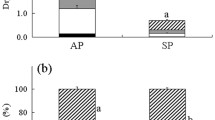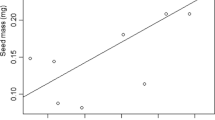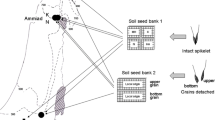Abstract
Regulation of seed germination phenology is an important aspect of the life history strategy of invading annual plant species. In the obligately selfing winter annual grass Bromus tectorum, seeds are at least conditionally dormant at dispersal in early summer and lose dormancy through dry-afterripening. Patterns of germination response at dispersal vary among populations and sometimes across years within populations. To assess the relative contribution of genotype and maturation environment to this variation, we grew progeny of ten parental lines from each of six contrasting populations in a common greenhouse environment. We then tested the germination responses of recently harvested seeds of the putative full-sib progeny at five incubation temperatures. Significant germination response differences among populations were observed in greenhouse cultivation, and major differences among full-sib families were evident for some populations and traits. Among-population variation accounted for over 90% of the variance in each trait, while within-family variance accounted for 1% or less. Germination responses of greenhouse-grown progeny were positively correlated with the responses of wild-collected seeds, but there was a tendency for lowered dormancy at higher incubation temperatures. This tendency was more marked in populations from cold desert, foothill, and plains habitats, suggesting a genotype-maturation environment interaction. Differences among populations in the amount of among-family variance were more evident at lower incubation temperatures, while among-family variance was more uniformly low at summer incubation temperatures. Populations from predictable extreme environments (subalpine meadow and warm desert margin) showed significantly less variation among families than populations from less predictable cold desert, foothill, and plains environments. Low among-family variance was not specifically associated with small population size or marginality of habitat, as small marginal populations from unpredictable environments showed variance as high as that of large populations. In populations with high among-family variance for germination traits, germination responses tended to be correlated across incubation temperatures, making it possible to characterize families in terms of their general dormancy status. The results indicate that seed germination regulation in this species is probably under strong genetic control, and that habitats with temporally varying selection are occupied by populations that tend to be more polymorphic in terms of their germination response patterns.
Similar content being viewed by others
Author information
Authors and Affiliations
Additional information
Received: 19 May 1998 / Accepted: 27 January 1999
Rights and permissions
About this article
Cite this article
Meyer, S., Allen, P. Ecological genetics of seed germination regulation in Bromus tectorum L. . Oecologia 120, 27–34 (1999). https://doi.org/10.1007/s004420050829
Issue Date:
DOI: https://doi.org/10.1007/s004420050829




